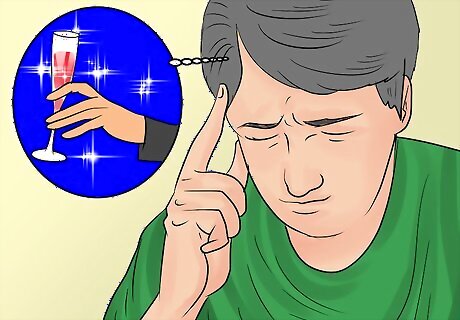
views
Getting All of the Details

Talk to the toastee. If you are giving a planned toast at an event, spend a few moments discussing the toast with the bride or groom (in the case of a wedding) or someone closely involved in the planning. Ask them what subjects, if any, they would like you to discuss in particular as well as any subjects they want you to avoid. They can also give you some insight regarding who will be attending the event. You can also express your reservations to the toastee if you would like to participate but are too nervous to do so. Just because you are asked to give a toast does not mean you have to, especially if you suffer from social anxiety.

Know the speaking order. Find out when you will be asked to speak and who will be going directly before you, if there will be a series of toasts. If you are giving a spontaneous toast then you don’t need to worry about order and will instead want to look for a good time when you can get everyone’s attention. Rehearsal dinner toasts are usually informal with the hosts generally addressing everyone followed by anyone else who wishes to jump in. At a wedding, the best man and maid of honor offer the first toasts followed by the bride and groom. The parents then have a chance followed by any of the guests. At a casual dinner party it is best to wait until the dinner or first course plates are collected before you offer a toast.

Understand any time constraints. Short toasts are the best toasts. A wedding toast should last for right around 3 minutes. If you hit 5 minutes, you have gone too long. It is best to keep a dinner party toast at a minute or less. You want to keep your audience curious for more, not begging you to wrap up.

Be aware of the atmosphere. Make sure that both the content and how you deliver the toast suits the occasion. It is okay to make a few jokes, but don't include anything too lewd. It’s also a good idea to avoid cursing so you don't risk offending random attendees. If you are really worried, run your toast by the bride or groom to gauge their reaction and ask for feedback. It is hard to establish a clear line for lewd humor, but most people find discussing sex or the wedding night to be in poor taste.

Know the local customs and etiquette. Toasting practices vary across cultures, so if you are planning on giving a toast at an unfamiliar locale you may want to research the norms beforehand. Even the placement of your glass matters. For instance, in China you try to keep your rim lower than others in order to show deference and respect.
Avoiding Common Mistakes

Practice. Spend some time in front of a mirror going through your toast in advance. If you will be speaking in front of a larger audience, try your toast out before a few of guests in advance. Watch for their reactions as you speak to know what you need to keep and what you should cut. Practicing will also help you to learn to moderate the volume of your voice. Nothing is worse than a mumbled or inaudible toast.

Memorize it. If you practice your toast enough, you will eventually be able to set aside your notes and speak directly from memory. You should anticipate speaking about 100 words per minute in a standard toast. If you mess up a part during the actual event, keep going as if nothing happened and (most likely) no one will know the difference. If necessary, you can use note cards while giving the toast. Remember to look up and make eye contact with the audience, though!

Omit any apologies. Don’t be the speaker who opens their toast by apologizing for what they don’t know or what they won’t say. This sets a poor tone for the whole thing. Instead, be confident and seize the moment. Tell the audience what you do know and why that matters. Instead of saying, “I don’t know Jerry very well, but here goes nothing,” you might try, “Those times when Jerry and I can hang out are action-packed and adventure-filled.”

Delete the inside jokes. It can be really tempting to use your toast as an opportunity to show everyone how close you are with the toastee. However, this can backfire and make your audience feel less connected to what you are saying. Instead, try to bring everyone together by relating stories that touch on subjects that all people can relate to like friendship, love, or family. However, it is acceptable to share an inside story, as long as it portrays the person you are toasting in a positive way. Just be sure to explain enough so that everyone understands the joke.

Try to relax. If you are nervous, take a few deep calming breaths before standing up to speak. Repeat to yourself, “I can do this,” and then do it. Resist the urge to use alcohol to relax beforehand and this can have horrible consequences when public speaking.
Creating Your Toast

Get everyone’s attention. Before you begin to speak you’ll need to get the attention of your audience. It is best to stand up and say something similar to, “I’d like to give a toast.” This announces your intentions and people will look toward you out of curiosity. Remain standing as you start to speak and raise your glass as well. The old practice of tapping your glass with a knife has now gone by the wayside. A series of glass-tapping toasts can quickly get annoying at a big event. Instead, get attention with a confident voice and consistent eye contact. Use a microphone, if one is available.

Open with a strong “hook.” Your first line is critically important as this is how you will convince everyone to actively listen to you. Open with a funny or intriguing tidbit about the subject of your toast. Don’t over-promise, but don’t provide too many details at this point either. Make your first few lines about the toastee, not you. Avoid using, “I” or “me/my,” to keep your focus, and that of your audience, on the person or persons of the hour.

Provide a bit of background. After your opening sentence, it is a good idea to give 1-2 lines about your background and relationship to the toastee. Keep this information brief, tailored to the event, and humorous. You’ll also want to give your audience enough background so that they will be able to follow any stories that you provide. You might say, "I'm the groom's brother and football-watching buddy."

Include a central story. You’ll want to add in at least one, perhaps a few more, fleshed-out stories as the centerpiece of your toast. These stories should be personal, but not intimate or overly embarrassing. They should explain to your audience why the person is worth toasting to begin with. For example, you might tell the story about the time that you and your brother (the groom) backpacked through Europe. Or, share a story about the person you are toasting and other family members or friends that are in attendance to keep the focus off of yourself.

Emphasize sensory elements. Make your listeners experience the story along with you by replacing boring descriptors with lively ones. The mud in the story wasn’t just stinky, it was rancid. The situation wasn't just concerning, it was dire. Play off of as many of the senses as you can.

Keep it positive. No one wants to listen to a depressing or high-handed toast. Be flattering to all parties involved. Find something nice to say, even if you don’t know them that well. Minimize the teasing and instead stick to general humor. If you are doubting including a particular moment, trust your initial instincts and leave it out. Leave out all mentions of exes, especially in a wedding toast. No one wants to listen to a story about a prior relationship when they are trying to celebrate a new one. Omit all negative jokes or jabs about the state of marriage. These remarks are generally cliché and bring the mood of the party down as well.

Include the audience. The best toasts are the ones that are almost interactive in nature. If you know audience members, call out to them when you can. Ask them to back you up with a quick, “Am I right?” You can also foreshadow your stories by warning the audience members involved with a quick, “Stan, this story is about you buddy!”

Be sincere. Some people try to be so funny during their toast that it comes off as insincere and forced. Instead, try to intermix laughs with heartfelt emotions. Let your audience know how you truly feel about the object of your toast.

Conclude with a wish and your thanks. At the end of your toast, signal that you are done by thanking the audience, your hosts, and/or the object of your toast. Offer heartfelt congratulations or a brief wish of well-being. Request that everyone else join you in these sentiments, lift your glass, and then take a sip. A solid concluding line for a wedding toast is always, ““Ladies and gentlemen, to the couple.”




















Comments
0 comment